Lyons W.C. (ed.). Standard handbook of petroleum and natural gas engineering.2001- Volume 1
Подождите немного. Документ загружается.


Hoisting System
575
(text
conlznued
from
page
571)
of the strand, by brazing or electric welding. Joints shall be spaced in accordance
with the equation
J
=
24D (4-23)
where
J
=
minimum distance between joints in main wires in any one strand in
in. mm
D
=
nominal diameter of wire rope in in. mm
Wire rope is most often furnished preformed, but can be furnished non-
preformed, upon special request by the purchaser.
A
preformed rope has the
strands shaped to the helical form they assume in the finished rope before the
strands have been fabricated into the rope. The strands of such preformed rope
shall not spring from their normal position when the seizing bands are removed.
Cable tool is one of the few applications for which nonpreformed is still used.
The Lay
of
Finished Rope.
Wire rope shall be furnished right lay or left lay
and regular lay or Lang lay as specified by the purchaser (see Figure
4-64).
If
not otherwise specified on the purchase order, right-lay, regular-lay rope shall
be furnished. For
6x7
wire ropes, the lay of the finished rope shall not exceed
eight times the nominal diameter. For
6x19,
6x37,
6x61, 6x91,
and
8x19
wire
rope, the lay of the finished rope shall not exceed
7+
times the nominal
diameter. For flattened strand rope designations
6x25
“B,”
6x27
“H,”
6x30
“G,”
and
6x31
“V,”
the lay of the finished rope shall not exceed eight times the
nominal diameter.
Diameter
of
Ropes and Tolerance Limits.
The diameter of a wire rope shall
be the diameter of a circumscribing circle and shall be measured at least
5
ft
(1.52
m) from properly seized end with a suitable caliper (see Figure
4-65).
The
diameter tolerance* of wire rope shall be
Nominal inch diameter:
-0%
to
+5%
Nominal mm diameter:
-1%
to
+4%
Diameter of Wire and Tolerance Limits.
In separating the wire rope for gaging
of wire, care must be taken to separate the various sizes of wire composing the
different layers of bright (uncoated), drawn-galvanized, or galvanized wires in
the strand. In like-positioned wires total variations of wire diameters shall not
exceed the values of Table
4-24.
Fiber Cores.
For all wire ropes, all fiber cores shall be hard-twisted, best-quality,
manila, sisal, polypropylene, or equivalent. For wire ropes of uniform diameter,
the cores shall be of uniform diameter and hardness, effectively supporting the
strands. Manila and sisal cores shall be thoroughly impregnated with a suitable
lubricating compound free from acid. Jute cores shall not be used.
*A
question may develop as to whether
or
not the wire rope complies with the oversize tolerance. In
such cases, a tension
of
not less than
10%
nor more than
20%
of
nominal required breaking strength
is applied to the rope, and the rope is measured while under this tension.
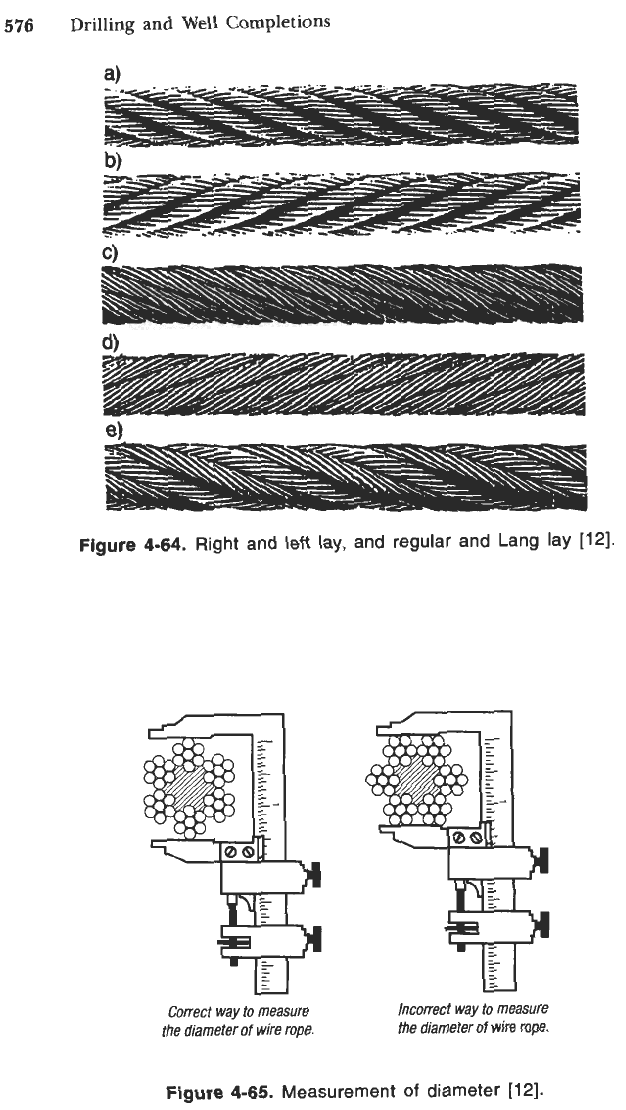
576
Drilling and Well Completions
a)
Figure 4-64.
Right and
left
lay,
and
regular and Lang lay
[12].
Correct way
to
measure
the diameter
of
wire rope.
Incorrect way to measure
the diameter
of
wire rope.
Figure 4-65.
Measurement
of
diameter
[12].
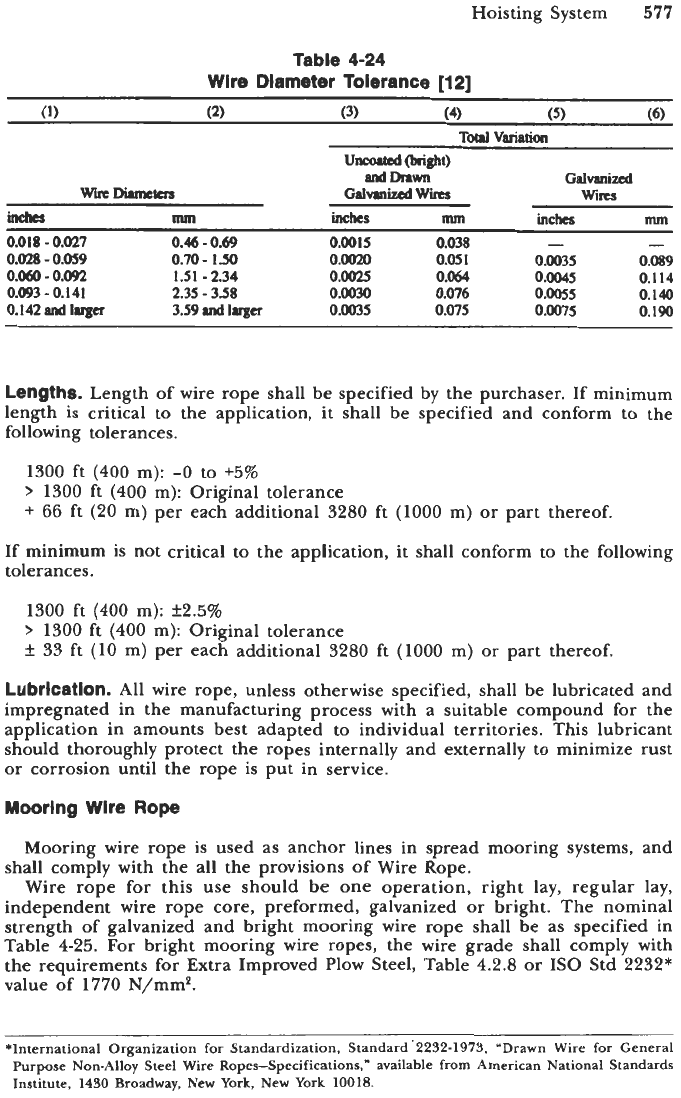
Hoisting System
577
Table
4-24
Wire Diameter Tolerance
[12]
Galvanizal
wires
Wnr
Dimwas
inches
mm
kkS
mm
inches
mm
0.01
8
-
0.027
0.46
-
0.69
0.00
1
5
0.038
-
-
O.Cn8
-
0.059
0.70
-
150
O.Oo20
0.05
1
0.0035
0.089
0.060
-
0.092
1.51
-
2.34
0.m
0.064
0.0042
0.114
0.093
-
0.141
2.35
-
358
0.0030
0.076
0.0055
0.140
0.142
ad
larger
3.59
md
larger
0.0035
0.075
0.0075
0.190
Lengths.
Length of wire rope shall be specified by the purchaser. If minimum
length is critical to the application, it shall be specified and conform to the
following tolerances.
1300 ft
(400
m):
-0
to +5%
y
1300 ft
(400
m): Original tolerance
+
66
ft (20 m)
per
each additional 3280 ft
(1000
m) or part thereof.
If minimum is not critical to the application, it shall conform to the following
tolerances.
1300 ft
(400
m): f2.5%
rt
33
ft
(10 m) per each additional 3280
ft
(1000
m) or part thereof.
1300 ft
(400
m): Original tolerance
Lubrication.
All wire rope, unless otherwise specified, shall be lubricated and
impregnated in the manufacturing process with a suitable compound for the
application in amounts best adapted to individual territories. This lubricant
should thoroughly protect the ropes internally and externally to minimize rust
or corrosion until the rope is put in service.
Mooring Wire
Rope
Mooring wire rope is used as anchor lines in spread mooring systems, and
shall comply with the all the provisions of Wire Rope.
Wire rope for this use should be one operation, right lay, regular lay,
independent wire rope core, preformed, galvanized or bright. The nominal
strength of galvanized
and
bright mooring wire rope shall be as specified in
Table
4-25.
For
bright mooring wire ropes, the wire grade shall comply with
the requirements for Extra Improved Plow Steel, Table
4.2.8
or
IS0
Std 2232*
value of 1770 N/mms.
*International Organization
for
Standardization, Standard
'2232-1973,
"Drawn Wire
for
General
Purpose Non-Alloy Steel Wire Ropes-Specifications," available
from
American National Standards
Institute,
1430
Broadway, New
York,
New
York
10018.
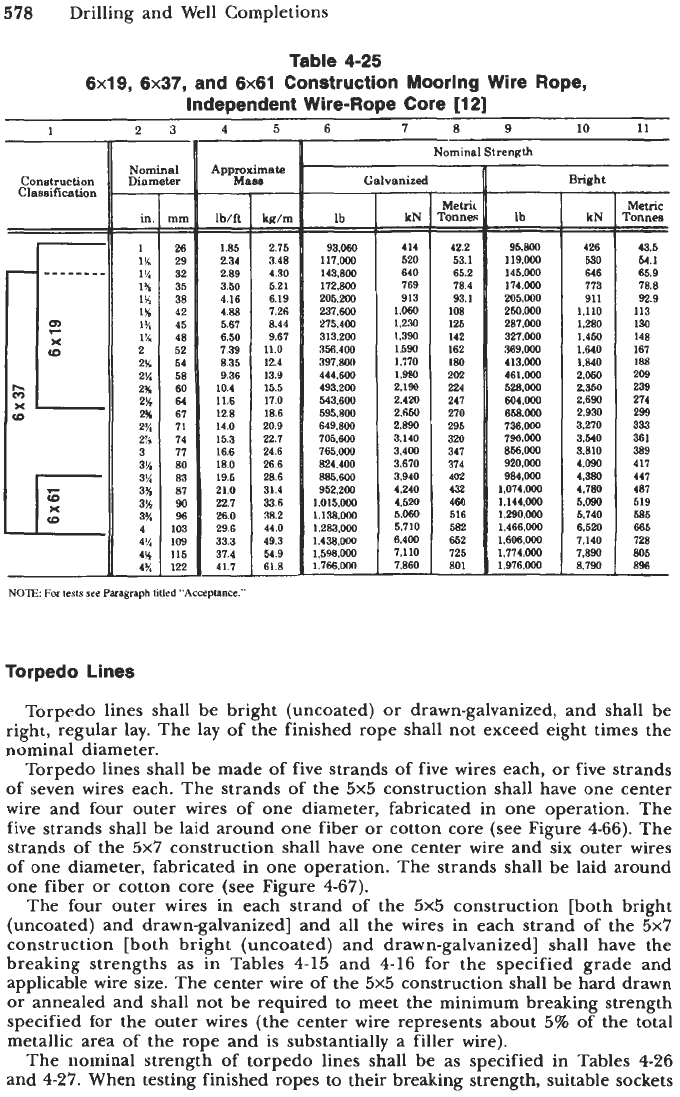
578
Drilling and Well Completions
Table
4-25
6x19, 6x37,
and
6x61
Construction Mooring Wire
Rope,
Independent Wire-Rope Core
[12]
4
5
6
78
9
10
11
11
in.
q
4w
4%
1
1%
1%
1%
1%
1%
1%
1%
2
2%
2%
2K
2%
2%
2%
2%
3
3K
3%
3%
3%
3%
4
4
IL
-
mm
26
29
32
35
38
42
45
48
52
54
50
60
64
61
71
74
17
80
83
87
90
96
103
109
115
122
- -
-
1
Nominal Strength
Approximate Galvanized
Maan
-
lb/fi
=
1.89
2.34
2.89
3.50
4.16
4.88
5.67
6.50
7.39
8.35
9.36
10.4
11.6
12.8
14.0
15.3
16.6
18.0
19.5
21.0
22.7
26.0
29.6
33.3
37.4
41.7
-
I
143.800
172.800
13.9
444,IXU
15.5
I
493.200
170
543.600
kN
414
520
640
769
913
1.060
1.2.10
1.390
1.590
1.770
1.980
2.190
2.420
2.650
9.890
3,140
3.400
9.670
3.940
4.240
4,520
5.060
5.710
6.400
7,110
7.860
-
-
-
Metric
ronnes
42.2
53.1
65.2
18.4
93.1
-
-
108
125
142
162
180
2M
224
241
270
295
320
341
374
402
432
460
616
582
662
725
801
-
lb
95.800
119.000
145.000
174.000
205.000
250.000
287.000
927.000
389.000
413.000
461.000
528.000
604.000
658.000
736.000
796.000
856.000
920,000
984.ooO
1.074.000
1,144,000
1,290.000
1.466.000
1,606,000
1.774.000
1.976.000
-
Bright
kN
426
5.30
646
773
911
1.110
1.280
1.450
1.640
1.840
2050
2,350
2.690
2.930
3.270
3.640
5.810
4.090
4.980
4.780
5.090
6.740
6.520
7.140
1,890
8.790
-
-
-
-
Metric
Ponnes
-
43.5
64.1
65.9
78.8
62.9
113
180
I48
167
188
209
239
274
299
333
361
389
417
447
519
MS
665
728
805
896
4x7
-
NO7E:
Far
rests
see Paragraph
titled
“Acceptance.”
Torpedo Lines
Torpedo lines shall be bright (uncoated)
or
drawn-galvanized, and shall be
right, regular lay. The lay of the finished rope shall not exceed eight times the
nominal diameter.
Torpedo lines shall be made of five strands of five wires each,
or
five strands
of seven wires each. The strands of the
5x5
construction shall have one center
wire and four outer wires of one diameter, fabricated in one operation. The
five strands shall be laid around one fiber
or
cotton core (see Figure
4-66).
The
strands of the
5x7
construction shall have one center wire and six outer wires
of one diameter, fabricated in one operation. The strands shall
be
laid around
one fiber
or
cotton core (see Figure
467).
The four outer wires in each strand of the
5x5
construction [both bright
(uncoated) and drawn-galvanized] and all the wires in each strand of the
5x7
construction [both bright (uncoated) and drawn-galvanized] shall have the
breaking strengths as in Tables
4-15
and
4-16
for the specified grade and
applicable wire size. The center wire of the
5x5
construction shall be hard drawn
or
annealed and shall not be required to meet the minimum breaking strength
specified for the outer wires (the center wire represents about
5%
of the total
metallic area of the
rope
and
is
substantially a filler wire).
The nominal strength of torpedo lines shall be as specified in Tables
4-26
and
4-27.
When testing finished ropes to their breaking strength, suitable sockets
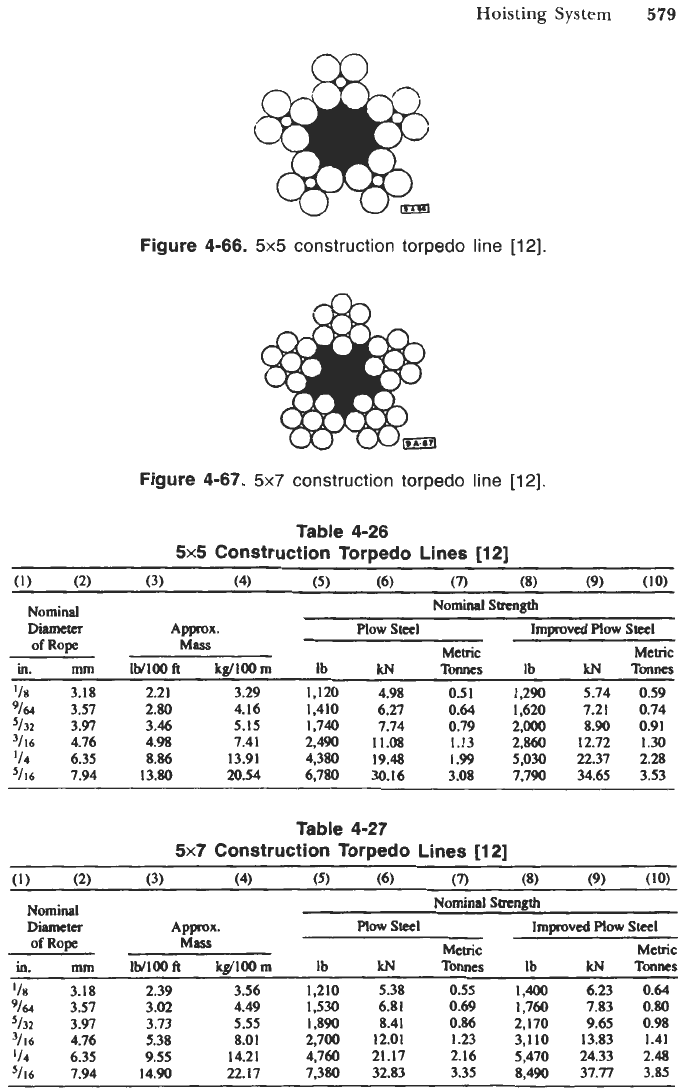
Hoisting
System
579
M
Figure
4-66.
5x5
construction torpedo line
[12].
Figure
4-67.
5x7
construction torpedo line
[12].
Table
4-26
5x5
Construction Torpedo Lines
[12]
(1) (2) (3) (4)
(5)
(6) (7)
(8)
(9)
(10)
Nominal
D-ter
Approx.
Plow
Steel
Improved
Plow
Steel
Metric Metric
of
Rope
Mpss
in.
mm
lW1OOfi
kg/lOOm
Ib
W
Tomes
Ib
W
Tonnes
'/a
3.18 2.2
1
3.29 1.1u) 4.98
051
1,290 5.74 0.59
9/64
3.57
2.80 4.16
1.410 6.27
0.64
1,620 7.21
0.74
'132
3.97
3.46
5.15
1.740
7.74
0.79
2.000 8.90
0.91
%6
4.76
4.98
7.41
2,490
11.08
1.13
2,860
12.72 1.30
'14
6.35
8.86
13.91 4.380
19.48
1.99
5,030
22.37
2.28
'116
7.94
13.80
20.54
6,780 30.16
3.08 7,790
34.65
3.53
Nominal
Strength
Nominal
Diameter
of
Rope
in.m
Table
4-27
5x7
Construction Torpedo Lines
[12]
(1)
(2)
(3) (4)
(5)
(6)
(7)
(8)
(9)
(10)
NominrlStrcngth
plow
Steel
Improved
Plow
Steel
Metric Metric
Ib
kN
Tmes
Ib
kN
Tonnes
1,210
5.38
0.55
1,400
6.23
0.64
1,530
6.81 0.69
1,760
7.83 0.80
1.890
8.41
0.86
2.170
9.65 0.98
x700
12.01 1.23
3.110
13.83 1.41
4,760
21.17 2.16
5,470
24.33 2.48
7,380
32.83 3.35
8.490
37.77 3.85
'In
3.18
'132
3.97
%6
4.76
'14
6.35
91~
3.57
5il6
7.94
APproX-
Mpss
lW100ft
kd1OOm
2.39 3.56
3.02 4.49
3.73
5.55
5.38
8.01
9.55 14.21
14.90 22.17
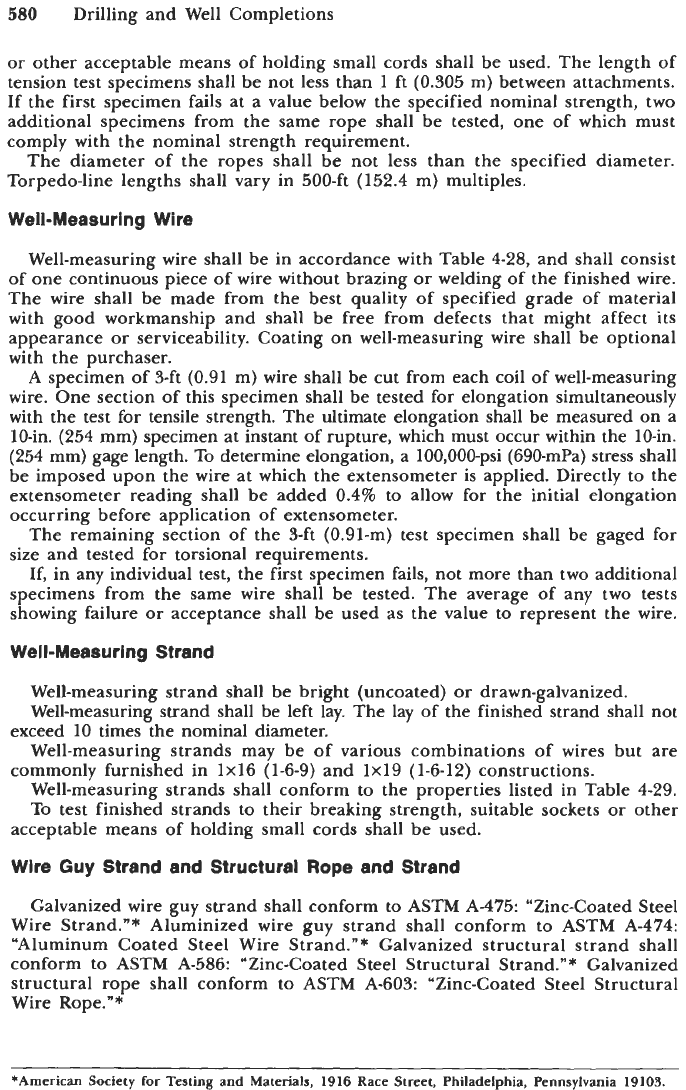
580
Drilling and Well Completions
or other acceptable means of holding small cords shall be used. The length of
tension test specimens shall be not less than
1
ft (0.305 m) between attachments.
If the first specimen fails at a value below the specified nominal strength, two
additional specimens from the same rope shall be tested, one of which must
comply with the nominal strength requirement.
The diameter of the ropes shall be not less than the specified diameter.
Torpedo-line lengths shall vary in 500-ft (152.4
m)
multiples.
Well-Measuring Wire
Well-measuring wire shall be in accordance with Table 428, and shall consist
of one continuous piece of wire without brazing
or
welding of the finished wire.
The wire shall be made from the best quality of specified grade of material
with good workmanship and shall
be
free from defects that might affect its
appearance or serviceability. Coating on well-measuring wire shall be optional
with the purchaser.
A specimen of 3-ft (0.91 m) wire shall be cut from each coil of well-measuring
wire. One section of this specimen shall be tested for elongation simultaneously
with the test for tensile strength. The ultimate elongation shall be measured on a
10-in. (254 mm) specimen at instant of rupture, which must occur within the 10-in.
(254 mm) gage length. To determine elongation, a 100,000-psi (690-mPa) stress shall
be imposed upon the wire at which the extensometer is applied. Directly to the
extensometer reading shall
be
added
0.4%
to allow for the initial elongation
occurring before application of extensometer.
The remaining section of the 3-ft (0.91-m) test specimen shall be gaged for
size and tested for torsional requirements.
If, in any individual test, the first specimen fails, not more than two additional
specimens from the same wire shall be tested. The average of any two tests
showing failure or acceptance shall be used
as
the value to represent the wire.
Well-Measurlng Strand
Well-measuring strand shall
be
bright (uncoated)
or
drawn-galvanized.
Well-measuring strand shall be left lay. The lay of the finished strand shall not
Well-measuring strands may be of various combinations of wires but are
Well-measuring strands shall conform to the properties listed in Table 4-29.
To test finished strands to their breaking strength, suitable sockets or other
exceed
10
times the nominal diameter.
commonly furnished in 1x16 (1-6-9) and 1x19 (1-6-12) constructions.
acceptable means of holding small cords shall be used.
Wire Guy Strand and Structural
Rope
and Strand
Galvanized wire guy strand shall conform to
ASTM
A-475:
“Zinc-Coated Steel
Wire Strand.”* Aluminized wire guy strand shall conform to
ASTM
A-474:
“Aluminum Coated Steel Wire Strand.”* Galvanized structural strand shall
conform to ASTM A-586: ”Zinc-Coated Steel Structural Strand.”* Galvanized
structural rope shall conform to
ASTM
A-603: “Zinc-Coated Steel Structural
Wire Rope.”*
*American Society
for
Testing and Materials, 1916 Race
Street,
Philadelphia, Pennsylvania 19103.
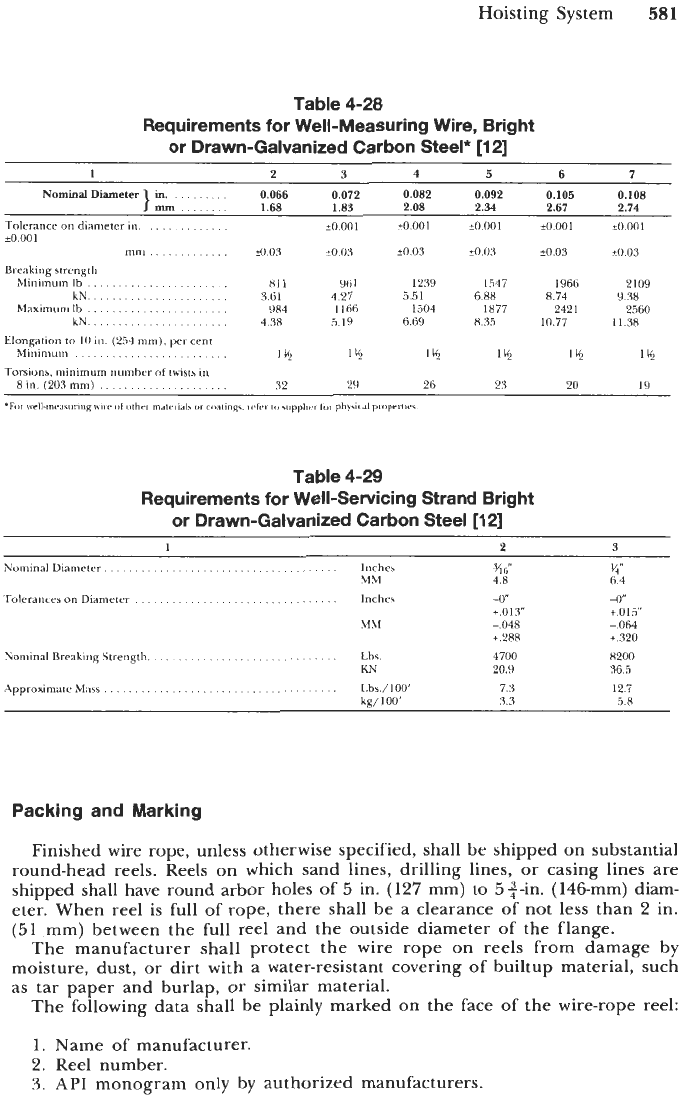
Hoisting System
581
Table 4-28
Requirements for Well-Measuring Wire, Bright
or Drawn-Galvanized Carbon Steel* [12]
I
2
3
4
5
6
7
Nominal
Diameter
0.066 0.072
0.082 0.092
0.105
0.108
Tolerance
on diameter
in.
,
.
, , , , , , ,
.
,
e0.001
+0.001
*0
001 tO.OO1 *0.001
}&I
::::::..
1.68
1.83
2.08
2.34 2.67
2.74
*0.001
Breaking srrength
mm
........
tO.03
to
03
t0.03
+0
03
t0.03
+o
03
Minimum
Ib
...................
811
Ytil
1?39
1547
1966
2109
....................
kN
3.61
4.27
5.51
6.88
8.74
9.38
kN..
..............
4.38
,519
6.69
x.35
10.77 11.38
...............
Maximum
Ib
9x4
1166
1504
1x77 2421 2560
Elongation to
10
111.
(254
mm),
percent
Torsions, minimum number
of
rwms
in
..................
Minimum
lY
1U
IrcL
lu,
Iu,
lu,
8
in
(203
mm)
............
32
29
26
23
zn
19
Table 4-29
Requirements for Well-Servicing Strand Bright
or Drawn-Galvanized Carbon Steel [12]
I
2
3
........................
Nominal Diameter
lnchea
'6
vs"
MM
4.8 6.4
'Tolerdncer
on
Diamctrr
. .
....................
lncher
-0"
-0"
+.013"
+.015"
MM -.048
-.064
r.288
+.320
.......................
Nominal Breaking Strength.
Lhs.
4700
x200
Approximate
Mass
L.bs./
100'
7.3 12.7
ke/100'
3.3
i.x
KN
20.9 36.5
..........................
Packing and Marking
Finished wire rope, unless otherwise specified, shall be shipped on substantial
round-head reels. Reels on which sand lines, drilling lines, or casing lines are
shipped shall have round arbor holes
of
5
in.
(127
mm) to
5
$in. (146-mm) diam-
eter. When reel
is
full of rope, there shall be a clearance of not less than
2
in.
(51
mm) between the full reel and the outside diameter of the flange.
The manufacturer shall protect the wire rope on reels from damage by
moisture, dust, or dirt with a water-resistant covering of builtup material, such
as tar paper and burlap, or similar material.
The following data shall be plainly marked on the face of the wire-rope reel:
1.
Name of manufacturer.
2.
Reel number.
3.
API
monogram only by authorized manufacturers.
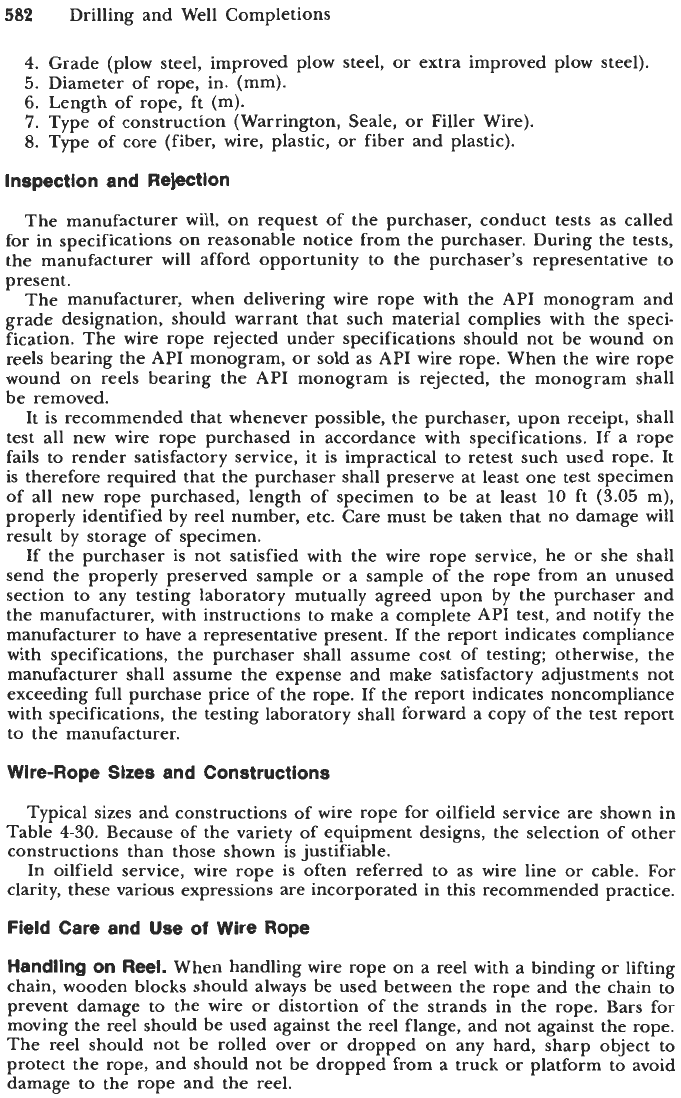
582
Drilling and Well Completions
4.
Grade (plow steel, improved plow steel, or extra improved plow steel).
5.
Diameter of rope, in.
(mm).
6.
Length of rope, ft (m).
7.
Type of construction (Warrington, Seale, or Filler Wire).
8.
Type of core (fiber, wire, plastic,
or
fiber and plastic).
Inspection and Rejection
The manufacturer will, on request of the purchaser, conduct tests as called
for in specifications on reasonable notice from the purchaser. During the tests,
the manufacturer will afford opportunity to the purchaser’s representative to
present.
The manufacturer, when delivering wire rope with the API monogram and
grade designation, should warrant that such material complies with the speci-
fication. The wire rope rejected under specifications should not be wound on
reels bearing the API monogram, or sold as API wire rope. When the wire rope
wound on reels bearing the API monogram is rejected, the monogram shall
be removed.
It
is
recommended that whenever possible, the purchaser, upon receipt, shall
test all new wire rope purchased in accordance with specifications. If a rope
fails to render satisfactory service, it is impractical to retest such used rope. It
is therefore required that the purchaser shall preserve at least one test specimen
of all new rope purchased, length of specimen to be at least
10
ft
(3.05
m),
properly identified by reel number, etc. Care must be taken that no damage will
result by storage of specimen.
If the purchaser is not satisfied with the wire rope service, he or she shall
send the properly preserved sample or a sample of the rope from an unused
section to any testing laboratory mutually agreed upon by the purchaser and
the manufacturer, with instructions to make a complete API test, and notify the
manufacturer to have a representative present. If the report indicates compliance
with specifications, the purchaser shall assume cost of testing; otherwise, the
manufacturer shall assume the expense and make satisfactory adjustments not
exceeding full purchase price of the rope. If the report indicates noncompliance
with specifications, the testing laboratory shall forward a copy of the test report
to the manufacturer.
Wire-Rope Sizes and Constructions
Typical sizes and constructions of wire rope for oilfield service are shown in
Table
4-30.
Because of the variety of equipment designs, the selection
of
other
constructions than those shown is justifiable.
In oilfield service, wire rope is often referred to as wire line or cable. For
clarity, these various expressions
are
incorporated in this recommended practice.
Field Care and
Use
of
Wire Rope
Handling
on
Reel.
When handling wire rope on a reel with
a
binding or lifting
chain, wooden blocks should always be used between the rope and the chain to
prevent damage to the wire or distortion of the strands in the rope. Bars
for
moving the reel should be used against the reel flange, and not against the rope.
The reel should not be rolled over or dropped on any hard, sharp object to
protect the rope, and should not be dropped from a truck or platform to avoid
damage to the rope and the reel.
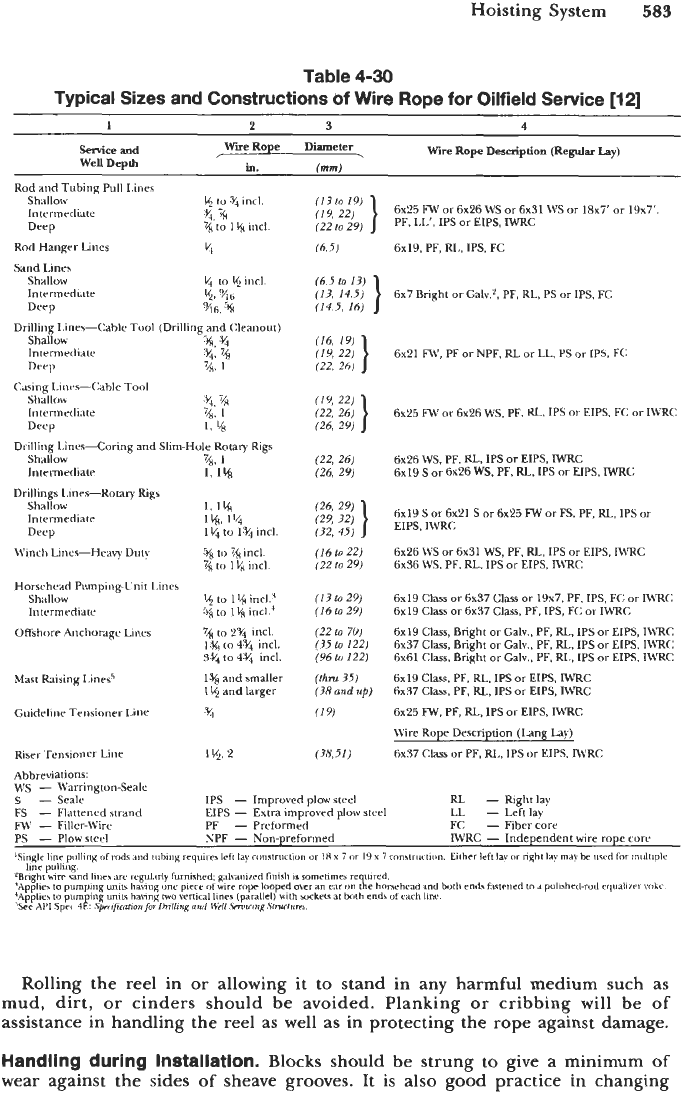
Hoisting System
583
Table
4-30
Typical Sizes and Constructions of Wire Rope for Oilfield Service
[I21
r
Wire
Rope
Diameter
Wire
Rope
Description
(Regular
Lay)
Senice and
Well
Depth
in.
hm)
Rod and Tubing Pull Iinm
Shallow
I$
IO
%
inrl.
Derp
%to
1
%
incl.
Intermediate
:%,
%
Rod Hanger Lines
Y
Sand
Linrs
Shallow
r/,
tn
U,
incl.
Intrrmrdiak
U,>
'&ti
Derp
%ti.
u
Shallow
%,
3
Intermrdiale
:%,
"k
Drrp
%,
1
Shallow
:&,
%
Intennediate
%.
I
Derp
1.
%
Shallow
%,
1
Drilling I.ines--I:ahle
Tool
(Drilling and Cleanout)
Casing Litim-Cable Tool
Drilling Lines-Cnling and Slim-Hole
Rotary Rigs
1,1%
In termediatr
Shallow
Inrrrmrdiarr
Drillings 1.inrs-Kotq Rigs
Deep
Winch Lines-Heavy Dutr
Horsehcad Pumping-Unit Lines
Shallow
lntrrmrdiate
Oftshore Anchorage Lines
Mast Raising lines"
Guidelinr Tensioner Line
Riser Tenqioner Line
Abbreviations:
WS
-
WarringtonSeale
S
-
Seale
FS
-
Flattened strand
FW
-
Filler-Wire
1,
1%
1%
11%
1
y
to
1%
incl.
to
%
incl.
7/R
to 1
&
iiicl.
L$
to
I
%
incl.$
%to
I&
iricl:'
%
to 2:% incl.
I.%$
to
4:&
incl.
3% to4% incl.
1%
and
smaller
1
t$
and
larger
%
l%,2
IPS
-
Imoroved nlow steel
6x25
FW
or
6x26 WS
or
6x31
WS
or
18x5'
or
19x7'
PF,
IL', IPS
or
EIPS,
WRC
6x19,
PF,
RI,,
IPS.
FC
6x7 Bright
or
Galv.', PF, RL, PS
or
IPS,
FC
6x21
FM',
PF or NPF,
RL
or LL, PS
or
IPS,
FC
6x25
FW
or
6x26
WS, PF,
RL,
IPS or EIPS, FC or
IWRC
6x26
WS,
PF,
RL,
IPS or EIPS,
IWRC
6x19
S
or
6x26
WS,
PF,
RL,
IPS or
UPS,
WRC
6x19
S
or
6x21
S
or
6x23
FW
or
FS,
PF,
RL,
IPS
or
EIPS, IWRC
6x26
WS
or 6x91 WS, PF,
RL,
IPS
or
EIPS,
IWRC
6x36
WS.
PF,
RL.
IPS
or
EIPS,
M'RC
6x19
Class
or
6x37 Class or 19x7, PF,
IPS,
FC
or
WRC:
6x19 Class
or
6x37
Class, PF, IPS,
FC
or
IWRC
fix19
Class,
Bright
or
Galv., PF,
RL,
IPS
or
EIPS, IWRC
fix37
Class,
Bright or Galv., PF,
RL,
IPS
or
EIPS.
IWRC
6x61
Class, Bright
or
Galv., PF, RI.,
IPS
or
EIPS.
IWRC
6x19
Class,
PF,
RL.
IPS
or
EIPS, IWRC
6x37
Class,
PF,
RL,
IPS
or
EIPS, WRC
6x25
FW.
FT,
RL,
IPS
or EIPS,
W'RC
Wire Rope Description (tang Lay)
6x37
Class
or
PF,
RL,
IPS or EIPS, IWRC
RL
-
Rirhtlav
Ir
0,
LIPS
-
Extra improved
plow
steel LL
-
Left lay
PF
-
Prrformed FC
-
Fiber core
PS
-
Plow steel NPF
-
Non-preformed IWRC
-
Independent wire
rope
coir
'Single
line pullin$
nrrods
and
whmg
requiter
iclt
lay
~~nslructi~n
UT
I8
x
i
01
19
x
7
CO~S~KLII~.
Either
left
Iav
or
riehf
I_
mdv
he
itred
for
~milf~pli.
%Fight
wire
sand
linrr
am regularly
furnished
gdvanitrd finish is
romrfirnra
required.
SApplirs
io
pumpjiig
unm
having
one
piece
of
wire
rope
looped
oycr
an
ear
on
the
homehead and
both
ends faiirned
to
P
puhshrrl-rod
eqtmlimr
xnhr
!.Applies
to
pumping units
havinz
two
vertical
line (parallel) with
mkeu
at
both
ends
ofeach line.
line pulling.
'See
AM
Spr,
IB:
S@fi&.rn
fmonlli~and
wrN.~~nn~.sM"ru.
Rolling the reel in or allowing it
to
stand
in
any harmful medium such
as
mud, dirt, or cinders should be avoided. Planking
or
cribbing will be
of
assistance in handling the reel
as
well as in protecting the rope against damage.
Handllng during Installation.
Blocks
should be strung
to
give a minimum
of
wear against the sides of sheave grooves. It is also good practice in changing
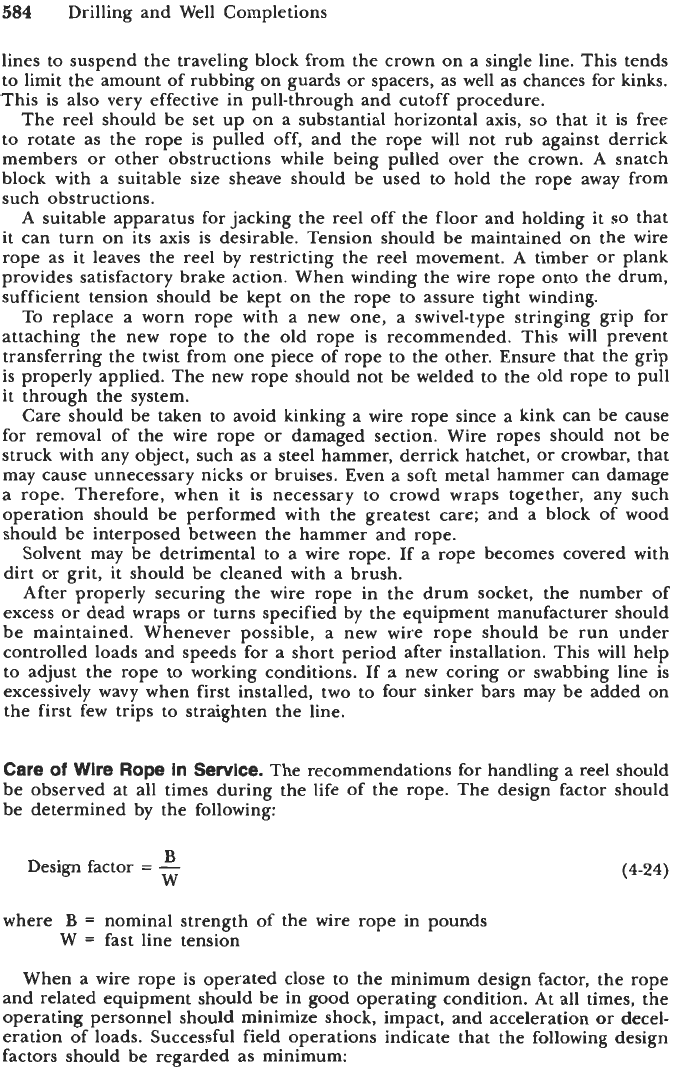
584
Drilling and Well Completions
lines to suspend the traveling block from the crown on a single line. This tends
to limit the amount of rubbing on guards
or
spacers, as well as chances for kinks.
This is also very effective in pull-through and cutoff procedure.
The reel should be set up on a substantial horizontal axis,
so
that it is free
to rotate as the rope is pulled off,
and
the rope will not rub against derrick
members
or
other obstructions while being pulled over the crown. A snatch
block with a suitable size sheave should be used to hold the rope away from
such obstructions.
A
suitable apparatus for jacking the reel off the floor and holding it
so
that
it can turn on its axis is desirable. Tension should be maintained on the wire
rope as it leaves the reel by restricting the reel movement.
A
timber
or
plank
provides satisfactory brake action. When winding the wire rope onto the drum,
sufficient tension should be kept on the rope to assure tight winding.
To replace a worn rope with a new one, a swivel-type stringing grip for
attaching the new rope to the old rope is recommended. This will prevent
transferring the twist from one piece of rope to the other. Ensure that the grip
is properly applied. The new rope should not be welded to the old rope to pull
it through the system.
Care should be taken to avoid kinking a wire rope since a kink can be cause
for removal of the wire rope
or
damaged section. Wire ropes should not be
struck with any object, such as a steel hammer, derrick hatchet,
or
crowbar, that
may cause unnecessary nicks
or
bruises. Even a soft metal hammer can damage
a rope. Therefore, when it is necessary to crowd wraps together, any such
operation should be performed with the greatest care; and a block
of
wood
should be interposed between the hammer and rope.
Solvent may be detrimental to a wire rope. If a rope becomes covered with
dirt
or
grit,
it
should be cleaned with a brush.
After properly securing the wire rope in the drum socket, the number of
excess
or
dead wraps
or
turns specified by the equipment manufacturer should
be maintained. Whenever possible, a new wire rope should be run under
controlled loads and speeds for
a
short period after installation. This will help
to adjust the rope to working conditions. If
a
new coring
or
swabbing line is
excessively wavy when first installed, two to four sinker bars may be added on
the first few trips to straighten the line.
Care
of
Wire
Rope
in Service.
The recommendations for handling a reel should
be observed at all times during the life of the rope. The design factor should
be determined by the following:
B
Design factor
=
-
W
(4-24)
where
B
=
nominal strength of the wire rope in pounds
W
=
fast line tension
When a wire rope is operated close to the minimum design factor, the rope
and related equipment should be in
good
operating condition. At all times, the
operating personnel should minimize shock, impact,
and
acceleration
or
decel-
eration of loads. Successful field operations indicate that the following design
factors should be regarded as minimum:
